It came as a surprise. When everyone thought the rangefinder camera had no future, the new Contax G System entered the stage. An all-new approach to this market segment, with a new mount, autofocus, automatic exposure, automatic film transport and Carl Zeiss lenses. Yashica Kyocera, the owners of the Contax brand, seemed to have pulled all the stops. The short lifespan of the Contax G system is a tragedy.
This camera came when it was least expected. In 1994, all the world used either SLR cameras of any denomination or one of the more or less sophisticated point-and-shoot-cameras. Kyocera already catered to both segments. But for whatever reason, they set out on a real adventure: an entirely new rangefinder system! It was the first new interchangeable lens rangefinder system since the launch of the Leica M in 1954. And they wanted to do it all differently, and with state-of-the-art features of the 1990s. After all, it was 32 years after the Contax IIIa, the last of the classical, German-made Contax rangefinder cameras was discontinued, leaving this market exclusively to Leica.
The Contax G System: A bold move in 1994
First came the Contax G1 in 1994. It was no Contax rangefinder in the classic sense. It did not use the bayonet mount of the then revolutionary, basically pre-war, Contax rangefinder system. Nor had it anything in common with what had become of the Leica M System by then. Just compare Leica’s flagship of the day, the M6 (slow textile cloth shutter, mechanical focusing, mechanical film advance, manual exposure), with the G1 (fast metal blade shutter, autofocus, built-in winder, option of auto exposure). Leica’s M7 was eight years away back then, and the Konica Hexar RF (considered by many “the better M7”) arrived only in 1999.
With the G1, four lenses were launched. The 45/2, a Planar design, was the standard optic and also came as a kit lens. The 28/2.8 was a Biogon (fairly symmetric design with a rear nodal point close to the film plane). The third lens in the initial setup was a 90/2.8 Sonnar. These lenses were Carl Zeiss branded but actually made in Japan, most likely by Kyocera themselves. With this line-up, most wishes of rangefinder photographers could be fulfilled. The Hologon 16/8 added an exotic touch to the initial line-up (more on this lens below). However, superfast designs were missing.
After only two years, Contax launches a second camera
But they were serious about the Contax G System project. Only two years later, an improved body was launched. The Contax G2 had an even faster shutter (up to 1/6000 sec.), better autofocus (now a hybrid passive-active system), and it was supposed to be more reliable mechanically. With the G2 came new lenses. Most notably, and with some delay, one was a world premiere. The 35-70/3.5-5.6 from 1999 was the first zoom for a rangefinder camera ever. And it took full advantage of the innovative Contax viewfinder. Other than the fixed-magnification Leica viewfinder with its frame lines for specific focal lengths, the Contax one would zoom, with automatic parallax compensation.
On the other hand, the Contax G System bodies are rangefinder cameras in the true sense of the meaning. Their autofocusing system works in exactly the way as a conventional rangefinder. Only the rangefinder patch is missing in the viewfinder. That means, if you want to use manual focus, you have to estimate the distance. The set value is displayed by an LC display in the viewfinder, but this is nowhere near as intuitive as focusing with a Leica M.
The Contax G System grows with more lenses
For this purpose, the zoom lens connects to the camera with seven electric contacts, making it incompatible with the older G1 body (it has only five contacts). And the lens line-up grew. The 35/2 was another Planar design and could also be attached to G1 bodies — at least if they were modified with new electronic components (a green sticker inside the film cartridge compartment would indicate this). A 21/2.8 was another Biogon design and needed an attachable viewfinder as well as the mentioned update to G1 bodies.
And the Hologon 16/8 had also returned with the G1! The latter took up an idea from decades ago: A fixed aperture extreme wide-angle lens without a diaphragm. The Zeiss Hologon 15 (just a tad wider) from 1972 for Leica M is well known among collectors. So, the idea of a contemporary relaunch of this lens with all the modern possibilities was quite promising.
The Contax autofocus systems leads almost into a dead end
In the end, the line-up consisted of two cameras (G1 and G2) and seven lenses (16, 21, 28, 35, 45, 90, and 35-70). All lenses apart from the 16 had autofocus. This was powered by a motor in the camera body and a screwdriver-type mechanical connection (similar to early Nikon AF SLR cameras). This is why there is nothing like a focus ring on the lenses. Manual focusing was by-wire, using a wheel on the camera. For the afterlife of the lenses, this is a serious obstacle, more on this later. All lenses had the Carl Zeiss label and the class-leading T* coating. They were made in Japan, apart from the 16/8 which has a Made in Germany engraving.
Many accessories make the Contax G system complete
The Contax G System, however, had more to offer than cameras and lenses. There were data backs for both bodies. Contax / Kyocera had a good reputation for this from the RTF SLR series. Both attachable flashes were, as had long become state of the art for all brands apart from Leica by the 1990s, TTL controlled. Users could also use the larger Contax SLR flashes. With an adaptor, it was even possible to attach Contax/Yashica SLR lenses to the Contax G System cameras. Lens hoods, bags, filters and some more accessories completed the programme. A sought after collector’s item is a special suitcase. Some Contax G System Components were also available in black; the standard colour was a slightly yellowish silver.
Who were the professionals for which the Contax G System was intended?
While attractive to the discerning amateur, the Contax G System never managed to convince the target group it was originally aimed at. I only ever met one professional photographer who owned a Contax G. And this was mainly intended for personal work. Only a few years after the G System was launched, the digital revolution took off. Suddenly, no one wanted to buy something as old-fashioned as analogue rangefinder cameras. And the few who wanted despite all, obviously went for Leica.
The rest is known: Leica introduced the M7 as the first auto exposure M with its big advantage of compatibility with almost all M-Mount lenses ever made. By the time Leica launched the M8 as their first digital M body (but, mind you, not as the first digital M-Mount rangefinder camera ever) in 2006, Kyocera had already ceased all its activities on the photo market. The Contax G System was a dead end.
Not exactly Leica prices, but still expensive
How many Contax G cameras and lenses were ever sold is not clear. But what we know is that it was an expensive system. The G1 had a DM 1,498 price tag (approximately €750) and the G2 was DM 2,498 (€1,250) in the mid-1990s. That was more than many high-end SLR cameras in those days. For comparison: The retail price for a Leica M 6 was DM 4,398 (€2,199), according to this article, back then. The lenses cost DM 698 DM (€349) (45/2), 1,098 (€549( (28/2.8, 35/2, 90/2.8), 1,998 (€999) (21/2.8) or even the pretty outrageous sum of DM 4,798 (€2399) (16/8, Made in Germany).
Today, Contax G cameras and lenses are widely available on the second-hand market. They are beginning to command collectors’ prices, however, and there is now some risk in buying into the Contax G System. Spare parts are difficult to find. And there are few experts left who can repair such a complex piece of technology. The lenses can get a second lease of life with a Techart adaptor which provides an autofocus drive for the lenses when attached to a modern mirrorless camera (Nikon Z or Sony E; unfortunately there is no adaptor for L-Mount yet). From all what I hear, this adaptor works quite well. But you have to make sure your lenses are in excellent condition. Otherwise, the powerful motor in the adaptor could damage the mechanics of the lens, which would be nothing short of tragic.
Contax G to Leica M conversions are possible, but…
The other option is converting the exceptional Contax G System lenses to M-Mount. This is not trivial because an entirely new focusing helicoid is required (the Contax G lenses rely entirely on motor-driven focusing). Funleader offers DIY kits and full lenses of the Planar 45/2 and the Planar 35/2, both subject to availability (which has become difficult lately). Read here in the M Files about the converted 45/2. There is/was also a kit for converting the 16/8 Hologon into an M-Mount lens. For the 21, the 28 and the 90, no such kits are known to me. And the zoom can’t be converted for Leica M for obvious reasons.
And while we are at it: You can sometimes read that the modern Zeiss lenses for Leica M-Mount are basically the Contax G lenses in a different barrel. I do not think this is true. The newer Zeiss ZM lenses are made by Cosina, and one can assume that they were designed with the requirements of digital sensors in mind (especially light fall-off off axis). The Contax lenses are also significantly lighter (35/2: 150 grams for the Contax X and 230 for the ZM), and you can see differing numbers of lenses in the cross-sections.
The Contax G System was modern — maybe too modern to last
At any rate, you can have excellent shooting experiences with the Contax G System. Let alone the feeling of using a truly exotic camera that was one of the last to proudly stage a name full of history, Contax. In the history of photographic technology, the Contax G System might not be much more than a footnote. But as such, it is worth being remembered. Contax made a bold move back in the 1990s and had no real success with it. Ironically, the Contax G, which was actually so modern at its launch 30 years ago, suffered its fate precisely because technical progress had passed it by. The sensor became the standard recording medium instead of film, and new construction principles were established for super wide-angle lenses in particular.
What if… Contax had made a digital rangefinder camera?
And we can only speculate what would have happened had Kyocera decided to develop the first full-frame digital rangefinder camera instead of the first full-frame DSLR (the almost forgotten Contax N). Would they have found a solution for a sensor that works well with the wide-angle lenses, which are marvellous for use with film but so deeply rooted in the analogue age that they would challenge even a modern sensor?
But the products, if you are lucky to find a working camera, are lovely to this day. Let alone the images…
Read here why John Shingleton was not so happy with his Contax G camera.
The Contax T2 was once called “the word’s most fashionable camera”. Rightly so?
And what abut you? Ever fancied or even used a Contax G system camera? Or do you think this camera betrays all ideas of purist rangefinder photography? Have you tried Contax G lenses with an adaptor for Nikon Z or Sony E-Mount? And what is your theory why the technically outdated Leica M was able to survive the advanced Contax G?
Join the Macfilos subscriber mailing list
Our thrice-a-week email service has been polished up and improved. Why not subscribe, using the button below to add yourself to the mailing list? You will never miss a Macfilos post again. Emails are sent on Mondays, Wednesdays, and Fridays at 8 pm GMT. Macfilos is a non-commercial site and your address will be used only for communications from the editorial team. We will never sell or allow third parties to use the list. Furthermore, you can unsubscribe at any time simply by clicking a button on any email.

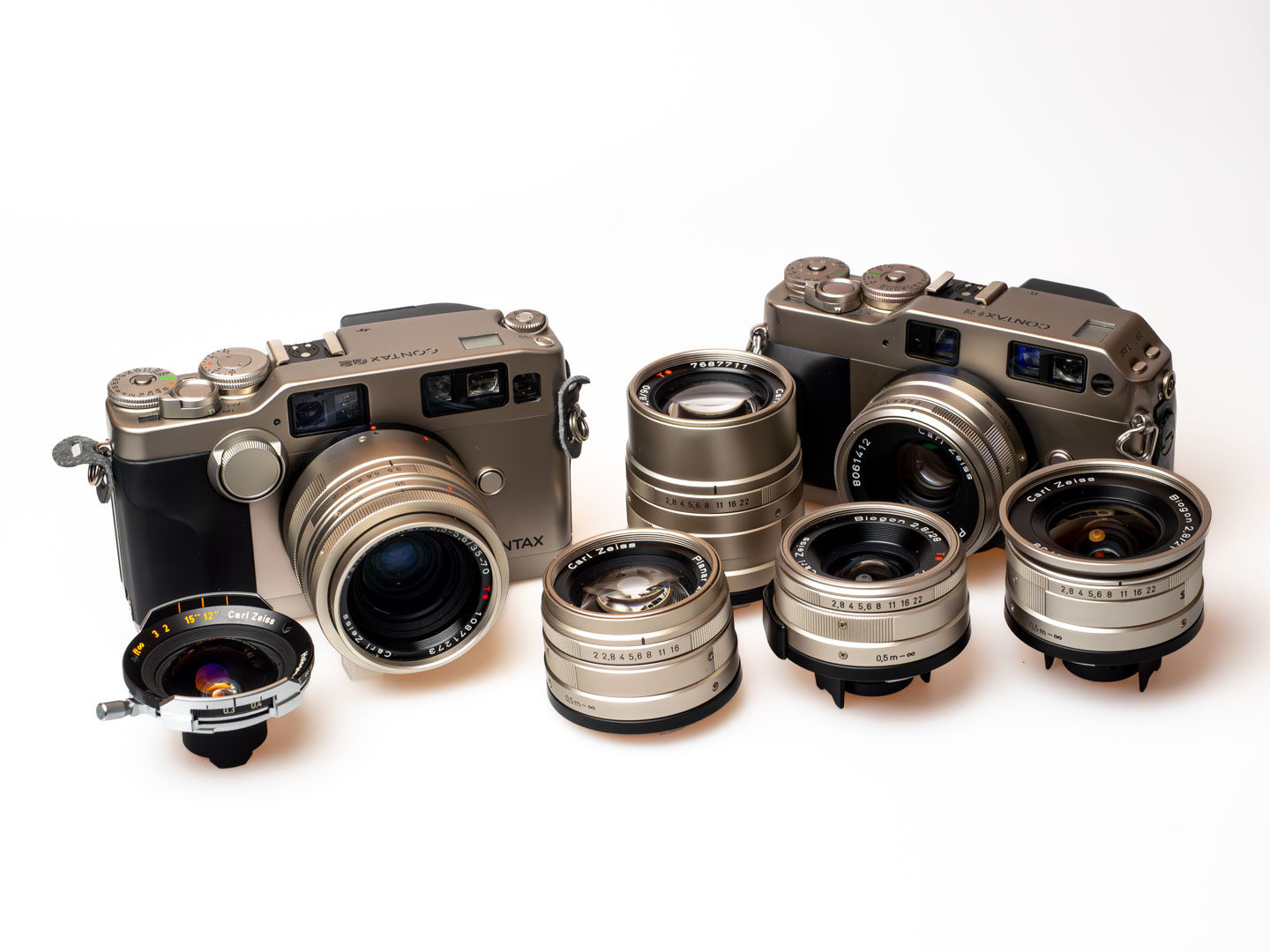
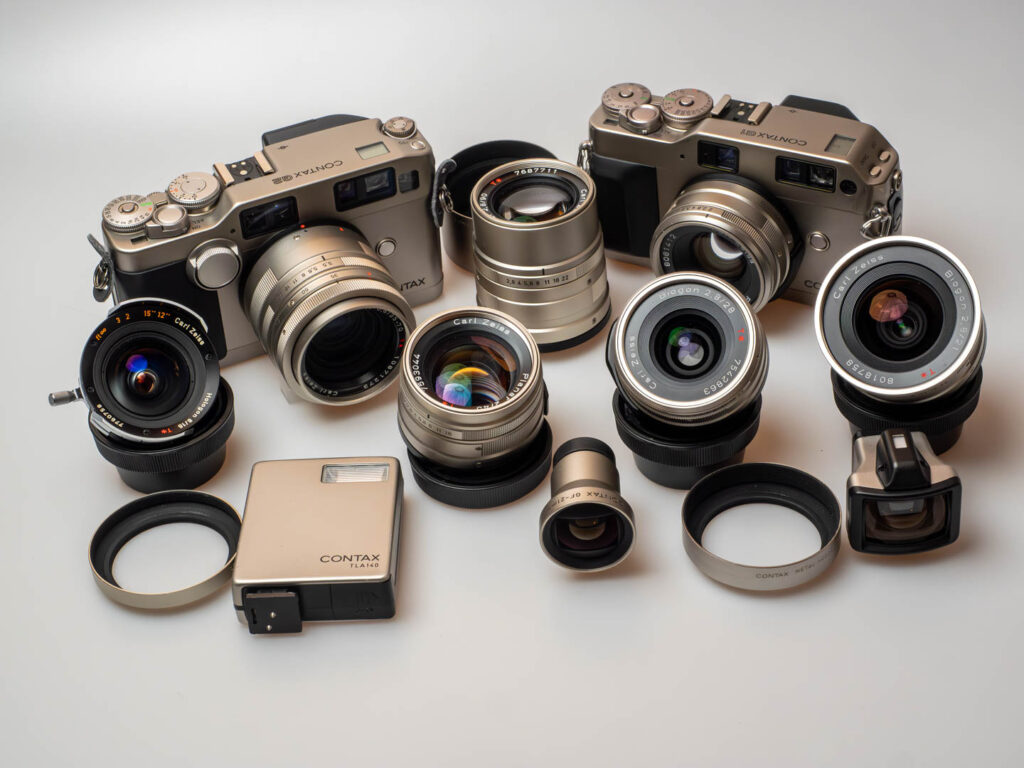
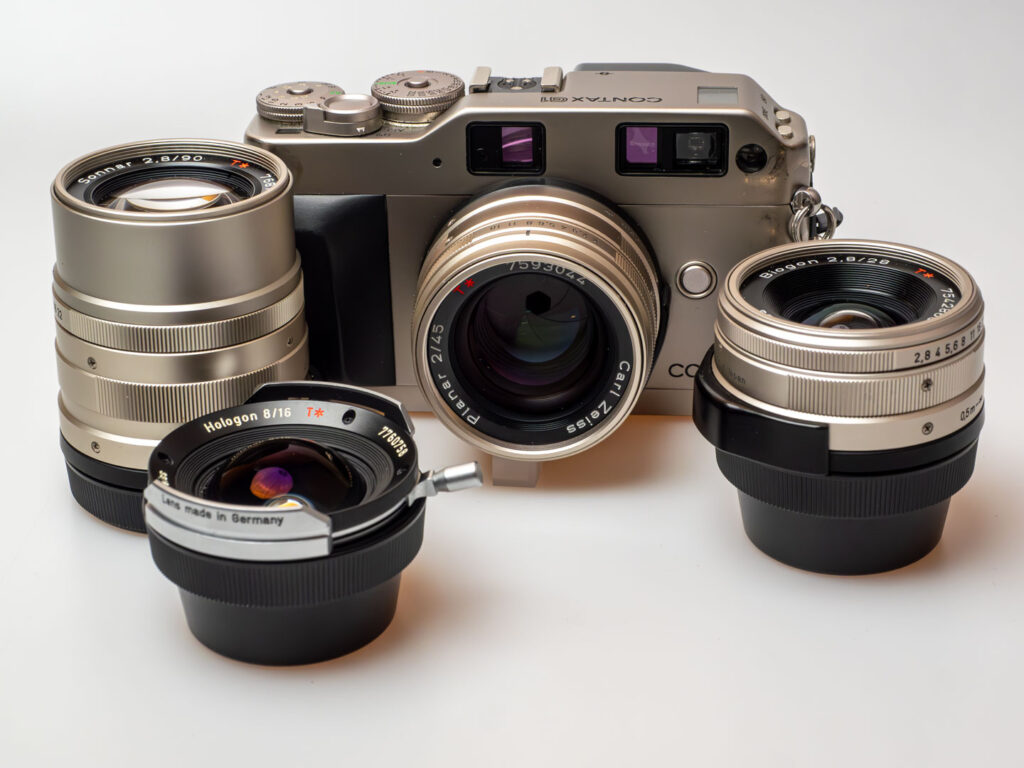

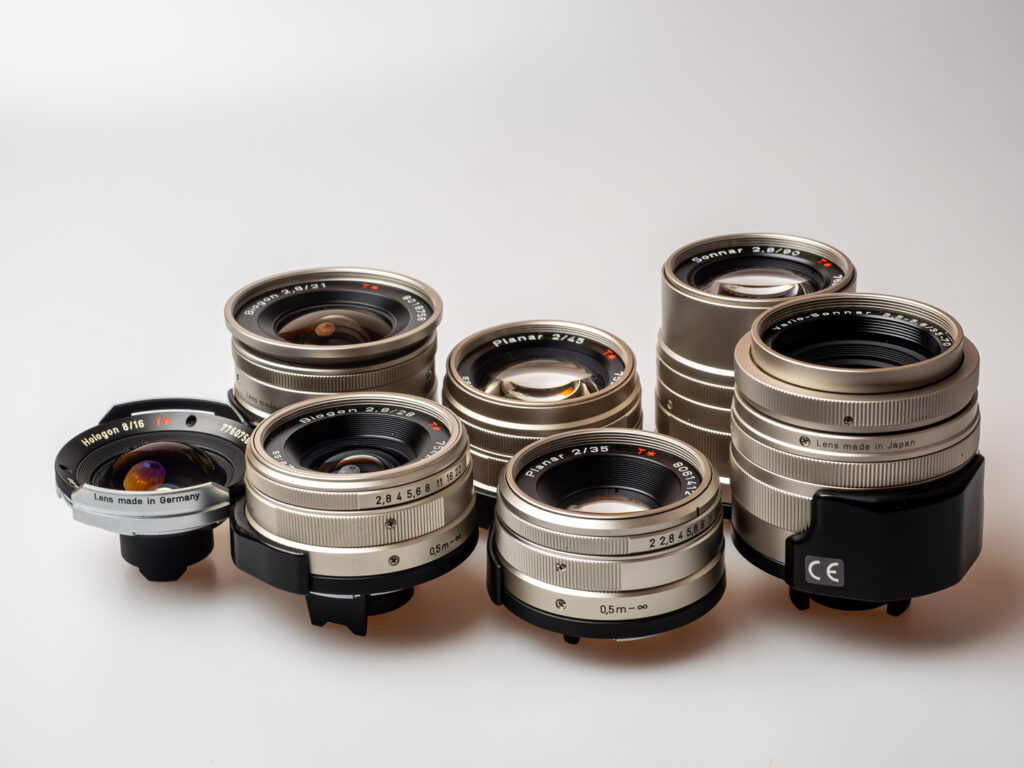
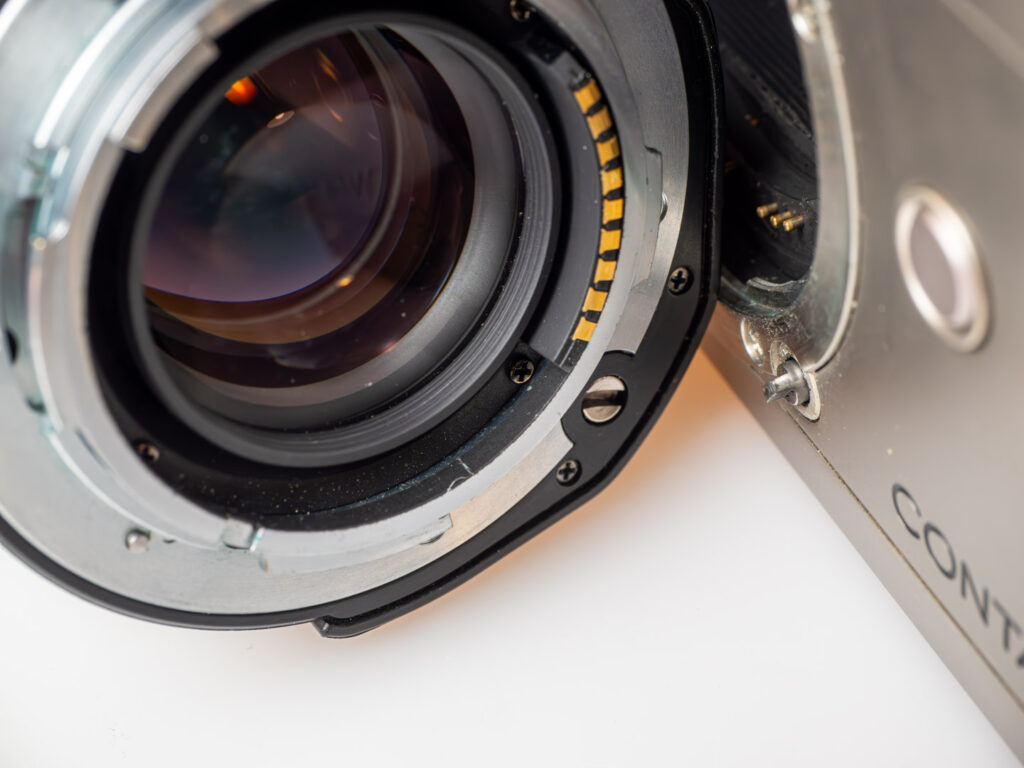
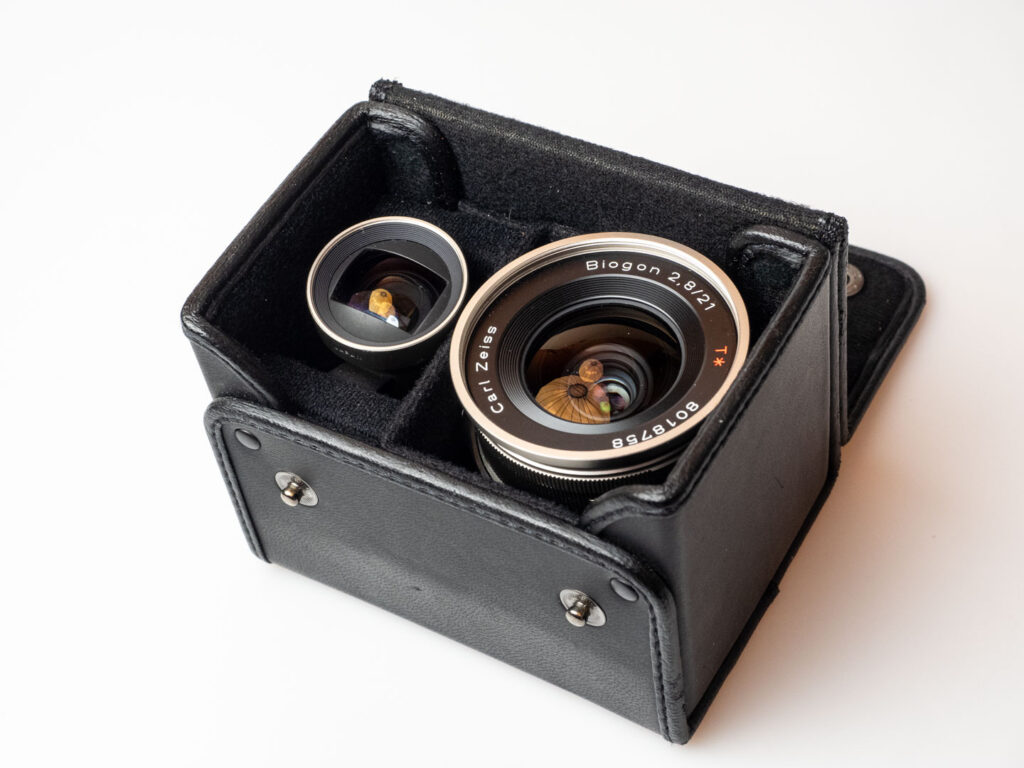

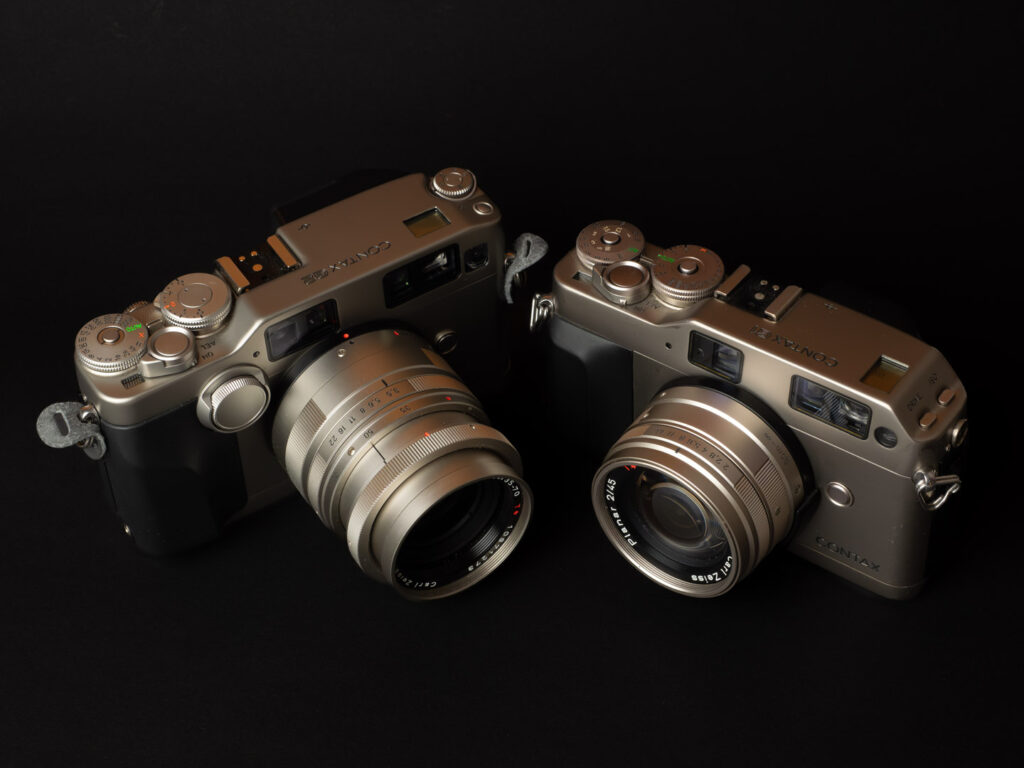
Leaving aside the question of whether an external phase-detect autofocus system constitutes a “rangefinder”… one significant drawback that hindered professional uptake of this system was the fact that you could never be REALLY sure the camera’s AF system had focused on the thing you wanted in focus! The AF brackets in the viewfinder weren’t perfectly aligned with the actual sensing area; the focusing readouts weren’t calibrated closely enough for fine distinctions; and there was no way to make visual confirmation as you can with a digital mirrorless viewfinder camera such as the Fujifilm X-Pros. Contax restricted the 90mm lens to an f/2.8 maximum aperture (and never offered any longer lenses) to put a fig leaf over this drawback, but those of us who tried to shoot portraits with these cameras found it a constant frustration. Poor electrical connection via the fragile contacts on the back of the lens and occasional jamming of the complicated mount when trying to interchange lenses were other annoyances (along with the high prices of hoods, caps, and other minor accessories.) Early in the G era I operated a website called the Contax G User Pages, which for a time was the most popular G camera online resource, and these were all frequent complaints. We users loved these cameras all right, but it was only their good looks and aura of exclusivity that made us put up with the frustrations of trying to use them…
“Leaving aside the question of whether an external phase-detect autofocus system constitutes a ‘rangefinder’… ”
I suppose technically it is not, since it is measuring light convergence within the camera body. Yet so are the rangefinders on classic cameras. For a time Polaroid made autofocus cameras that used a sonic rangefinder. But technically only measuring time lapse between sound pulses. Effectively all are “maximum focus achievers”, even classic rangefinder cameras. We don’t actually care what the distance is, do we? We are not lobbing projectiles; we just want sharp focus. [:-)
“we just want sharp focus. [:-)”
And THAT was the whole problem! With an optical rangefinder, you could at least be sure where the rangefinder patch sat on the subject (even if you couldn’t be sure all the associated coupling gizmos were coupling correctly.) With the G, since you couldn’t see what the phase detectors were detecting, you knew it was focusing accurately on SOMETHING, but not what! Maddening. It sometimes frustrates me that I didn’t hang onto my G1 and G2 outfit to cash in on today’s prices (especially for the little soft-leather system bag, which was beautiful but is now insanely priced considering how difficult it was to squeeze anything into or out of it) but I don’t actually miss using the cameras at all…
I don’t think the Zeiss ZM lenses were designed for digital. With the exception of one later addition, most of them were introduced with the Zeiss Ikon rangefinder film camera.
I wonder what practical difference it makes? I have heard of this issue film and sensor are not the same, but Nikon, which I am most familiar with, made a big deal out of most of the huge inventory of existing Nikon lenses could be used on their DSLRs.
I actually prefer to use my MF Nikkors on my Df, and I don’t see any issues with the results.
I think it is more of an issue on rangefinder cameras and mirrorless digital cameras, with the lens sitting closer to the film or sensor. Even so, many rangefinder lenses originally made for film cameras still work well on digital cameras. I was just pointing out that I don’t think the Zeiss ZM lenses were designed specifically for digital.
Hi Bryan,
thanks for your comment sorry for replying so late. You are right, the Zeiss ZM lenses were designed and launched together with the film-loading Zeiss Ikon camera. I wrote on this an episode for our long-running series, The M Files. Only the 35/1.4 came later and was obviously designed for the digital era.
In practical use however, many ZM lenses perform very well on digital sensors. Some others have issues with colour drift on the margins (the notorious „Italian flag“ effect). One key point is the distance between the rear nodal point and the light recording surface. In analogue use, a short distance can be quite desirable, and the Contax G 21mm lens is a good example for this – when used on a sensor, the light rays are coming in at ever steeper angles the farther you are away from the axis. The result is that the light might not or not entirely reach the bottom of the pixel well. And this problem is not easy to correct in post processing.
All the best, Jörg-Peter
I almost purchased the G2 and system. It was one of the most gorgeous cameras I have ever held. At the time it did not fit into my camera systems. I came very close to getting the card out. The glass and cameras were gorgeous.
Hi Brian, good to here that there are still people around who know and like the G System from the day back then. I was by no means able to afford it in the 1990s, but the look and feel the the products was gorgeous indeed. But it was, sadly, a dead end… All the best, Jörg-Peter
Well, I’ve never had any problems – unlike John Shingleton – with my G2 ..the batteries hold their charge – for me, anyway – for years, with a neat little display on the camera to show remaining power.
I don’t have the 16mm super-wide G lens (the 21mm is wide enough for me) but I do have all the others, plus a flash (which I haven’t used!) and a great Techart auto-focus adaptor for using the Contax G lenses on a Sony A7 series camera. Works perfectly!
Some people say that it’s awkward to focus successfully with the G 90mm lens, as you have to get whatever you want to focus on exactly in the very centre of the teeny focus-square in the middle of the finder. But, once again, it works for me! (Perhaps it’s more unusual, or awkward, for SLR users, rather than for rangefinder users.)
The ‘zooming’ finder – a great idea, which Leitz/Leica never implemented – does get rather tiny and hard to use, as its edges close in – to mask the edges of the image – the more that you zoom in. It’s a shame that Yashica/Kyocera/Contax never put a magnifying lens into that finder, so that as the edges pull in, reducing the size of the remaining view, the view might simultaneously increase in size so as to constantly fill the finder ..if you get what I mean! Some people say that the finder is like ‘looking down a tunnel’ ..but that’s rather an exaggeration.
The (two cameras of the) G ‘series’ were one of the last great gasps of the film era ..though, of course, they’re still great cameras if you do still use film. And the lenses do work well on, say, the Sony A7 cameras along with that specialised Techart autofocusing adaptor.
The G2 is fast to use (autofocus, automatic film wind), is a ‘smooth’ and elegant-looking camera, has a good range of lenses – although nothing longer than 90mm (the focus couldn’t be guaranteed accurate beyond that ..same with the Leica (film) CL).
The Leica M7 – another ‘film’s last gasp’ camera – was a step backwards from the G2, as, although it had (optionally) auto-shutter-speed-selection, it had no autofocus, no auto film wind and no general-purpose zoom lens (apart from the 28-50-35mm ‘Tri-Elmar’ and the super-wide Leica 16-18-21mm).
The G1 and G2 were not ‘too little’ by any means, but they were decidedly too late.
Dear David,
sorry for replying only so late. Thank you so much for all the knowledge you are adding here. There is a lot of expertise in what you are writing, and it is all in line with what I have learned so far. Maybe we can come back to you when we pick up the topic again, especially when it comes to digital performance of the G lenses. It would definitely be worth while to have a closer look at the whole system, but especially the lenses. The 45 is a stellar performer in the M-Mount conversion (with focusing helicoid and all) as performed by Funleader. So the other lenses might bring beautiful results as well…
All the best, Jörg-Peter
Thanks Jörg-Peter for the review of a much loved camera that I used for years before switching to a Leica R8 and a few summicrons.
I owned all the lenses apart from the zoom and the Hologon. They worked flawlessly, produced amazing images that include many keepers. Many photos from the G1 and the T2 still decorate the walls of the house. Hanging side by side with some Leica images there’s almost no difference in term of quality.
My pocket camera was the T2 although it did vignette a lot.
My G1 everyday lens was the Planar 35mm. Although it did not have so many positive reviews at the time, the quality of this lens was stellar. The second most used one was the planar 45mm. Many of my best portraits of my children were taken with the 45. It had great bokeh.
Had the ContaxG gone digital with a solution like the Leica Digital Module R I would certainly have kept the camera.
Now that digital photography has made things so much easier I doubt I’ll ever come back to analog photography. I still use an Olympus mju:II from time to time with B&W film but hardly more than 36 views a year.
Thanks again for taking me down memory lane
Jean
Dear Jean, thanks for your feedback. Only you can say if retuning to analogue is right for you, but I can say that I enjoy it from time to time. I hope I have, at one point, the opportunity to do extensive work with the Contax cameras and lenses. In this case, proper reviews might follow. This article is more meant as an overview. But it is nice to see that it rings a bell for quite a few readers. And yes, some nostalgia is justified when we consider that such a beautifully designed and made system was doomed to such a dead end. Best wishes, Jörg-Peter
Fascinating camera and article.
Made me wonder – didn’t the Nikon S series rangefinder cameras of the 1950s (plus the 2000 and 2005 remakes!) use the original Contax mount? What if Kyocera had retained the original Contax bayonet? Would have made for interesting cross-use possibilities? I wonder if Kyocera even considered this before embarking on this adventure.
The original Contax mount was too old and too small (34mm) and awkward to fit on the G cameras, which use a simpler straight-in-and-twist breech-lock 44mm mount. It’d have been difficult to include the G’s necessary electrical contacts in the smaller original Contax rangefinder mount – which was really a mixture of two mounts: an inner one and a separate outer one.
Nikon, too, abandoned the old Contax mount when they (Nikon) changed to making SLRs ..although they did, oddly, keep the ‘counter-intuitive’ anti-clockwise lens-mount twist for their SLRs!
” ‘counter-intuitive’ anti-clockwise lens-mount twist ”
Having used Nikons for 50 years, it never occurred to me that the F mount bayonet was counterintuitive! Neither did it occur to me that the focusing direction or aperture ring are “backwards” on a Nikon. I thought all others are backward!
I must be pretty ‘backward’ myself!
If you are, David, than I am as well. Never liked the Nikon lens twist. But i know many excellent photographers who never minded. JP
Hi Martin,
Thanks for commenting. I fact, the old Contax bayonet would have been ways too small to incorporate electronic contacts or an autofocus drive. So, they had to invent something new. In fact, there were not alternatives available. The Leica M Mount can‘t accommodate all the necessary functions of a modern camera/lens interface. So, it was clear from day one that this would stay a niche product. Maybe it also was a prestige project for the Yashica/Kyocera company. Similar things are being said about the Konica Hear RF rangefinder project – they, however, did not opt for autofocus and used the Leica M-Mount after the patent had expired.
Best wishes, JP